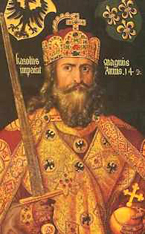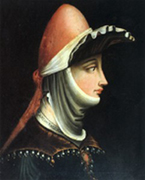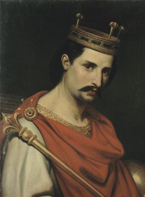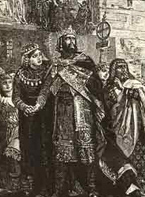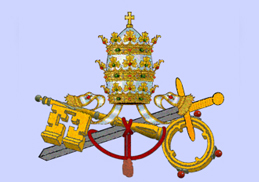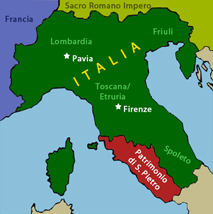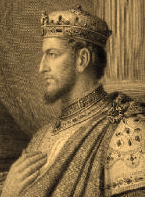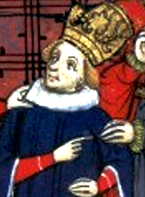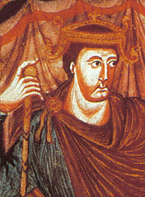|
|
The Kingdom of Italy was a constituent kingdom of the Holy Roman Empire from 781 through 1556. From 1801 - 1814, it was part of the Napoleonic Empire. After the fall of the Roman Empire, the Lombards, a Germanic people believed to be of Scandinavian origin from around the area of the Jutland peninsula, conquered the Italian peninsula and established the Kingdom of the Lombards, also known as the Lombard Kingdom of Italy. Its capital was Pavia, in northern Italy. In 774, the Lombard Kingdom came under the rule of Charlemagne after the Siege of Pavia. The Carolingian territory, however, only extended as far south as Spoleto and excluded both the Patrimony of St. Peter (Papal territories) and the mezzogiorno (southern Italy), which would remain under Lombard rule until it was conquered by the Normans in the 11th century. Charlemagne ruled as King of the Lombards from 774. In 800, he was crowned Emperor of the Romans (a title that would eventually become Holy Roman Emperor) by the Pope on Christmas day. The term "Kingdom of Italy" is believed to have been used for the first time in 781 when rule of Italy was given to Charlemagne's son Pepin. Pepin was crowned King by the Pope, using the Iron Crown of Italy/Lombardy. Upon his death in 810, rule of Italy passed to another of Charlemagne's sons, Bernard of Italy, who ruled the kingdom until 818. From 818, Italy was ruled by Lothair I of Italy, son of Louis the Pious, Holy Roman Emperor, and grandson of Charlemagne. Lothair was also Holy Roman Emperor from 817 until his death in 855. Thereafter, the Kingship of Italy remained with the house of Charlemagne until the death of Emperor Charles the Fat in 888. Thereafter, the crown passed to Berengar I, Margrave of Friuli. There was a period of instability with multiple claimants and attempts to take control of the crown. In 926, Hugh d'Arles, a member of a powerful family of Burgundian nobility, became King of Italy. His brother was Bosone, Margrave of Tuscany. Hugh was succeeded in 948 by his son, Lothair II of Italy. Upon Lothair's death in 950, the kingdom passed to Berengar II, a member of the Burgundian House of Ivrea. He was succeeded by his son, Adalbert of Italy. From 962, the Kingship of Italy returned as a personal union with the Holy Roman Emperor. Otto I, eldest son of Henry the Fowler, Duke of Saxony, was crowned both Holy Roman Emperor and King of Italy. Henry V, Holy Roman Emperor and King of Italy invested Countess Matilda, Margravine of Tuscany with the title of Vice-Queen of Italy and Imperial Vicar. Matilda, a staunch defender of the Papacy and a military leader, was a dominant figure in Italy. She was crowned Vice-Queen in 1111. Though the capital of the Kingdom was Pavia, the vice-royal capital was Florence, the capital of Tuscany/Etruria. Matilda died without issue and willed her lands to the Church. Thereafter, the Imperial Kingdom of Italy would slowly unravel, giving way to smaller states and the city-states for which much of Italy would become famous in the middle ages and Renaissance. Today, His Holiness the Bishop of Rome-Ruthenia holds the title of Imperial Lord of Italy in the Holy Roman Empire as the ecclesiastical successor of the Roman Empire and the ancient Margraviate of Tuscany in the Holy Roman Empire, and in descent from the ancient Margraves of Tuscany and Kings of Italy in the Holy Roman Empire. This titular patrimony is known as the Pontifical and Imperial Kingdom of Italy.
Patrimony of Sts. Peter and Stephen
|
|
